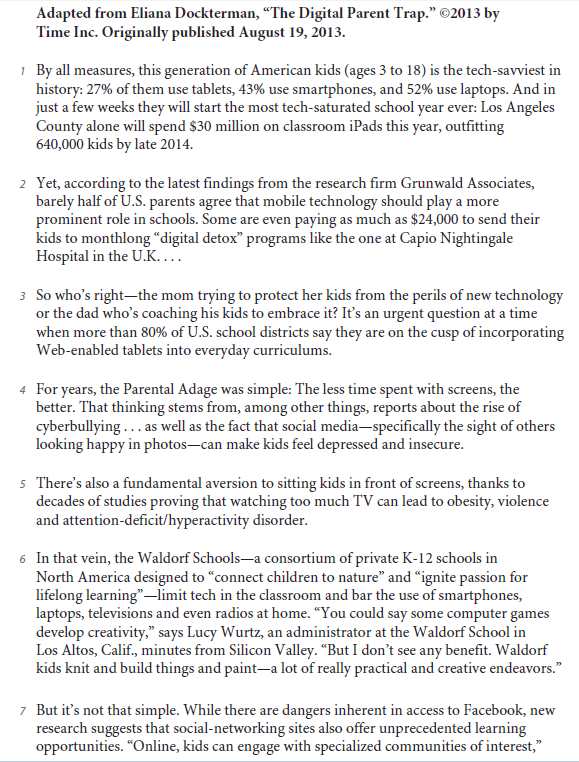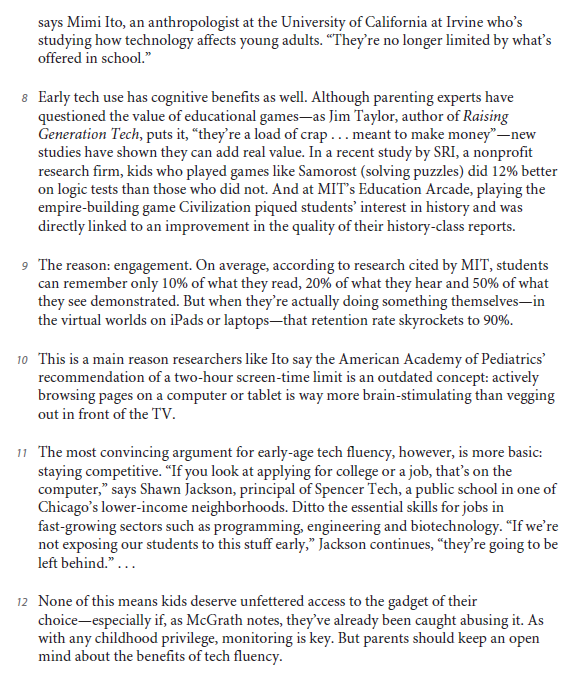摘要:为了能提高学生在SAT这块的写作技巧,除了不断的强化自己的词汇量和阅读能力,还要多读多看些的SAT写作范文。
为了能提高学生在SAT这块的写作技巧,除了不断的强化自己的词汇量和阅读能力,还要多读多看些的SAT写作范文。以下的SAT写作范文来自新航道SAT培训教研组,针对目前还苦于无从下手的考生们希望这些SAT写作范文能够给到你们帮助。
SAT写作真题:


SAT写作题目:
Write an essay in which you explain how Eliana Dockterman builds an argument to persuade her audience that there are benefits to early exposure to technology. In your essay, analyze how Dockterman uses one or more of the features listed in the box above (or features of your own choice) to strengthen the logic and persuasiveness of her argument. Be sure that your analysis focuses on the most relevant features of the passage. Your essay should not explain whether you agree with Dockterman’s claims, but rather explain how Dockterman builds an argument to persuade her audience.
In the article titled “The Digital Parent Trap”, Eliana Dockterman states that there are benefits for the younger generation to be exposed to technology. She builds her argument on the solid basis of sound research results and presents it in an unbiased manner via the ample use of exemplification mainly in the form of listing statistics.
Instead of jumping to her conclusion, Eliana begins the essay by pointing out a key feature of this presentOday American generation: they are the techOsavviest in history. And then she moves on to list people’s contrasting views regarding this phenomenon without picking a side to stand by.
The writer then examines the popular charges against tech fluency for young kids, which include Parental Adages’ against screens, the rise of cyberbullying, the negative impacts of social media as well as other problems associated with watching TV like obesity and violence. There are even practitioners in this veinOOthe Waldorf Schools where tech is literally banned so that the passion for lifelong learning can be ignited by engaging students in various kinds of practical and creative endeavors.
The turning point comes timely right after these and marks the writer’s counterattack: there are three major benefits of early tech exposure. To start with, socialOnetworking sites “offer unprecedented learning opportunities”, which means students can obtain information from a wide range of resources other than from schools. Another benefit is the development of cognition, for instance, in terms of their improvement in the ability of logic and producing qualified history reports. The key has been attributed to engagement. And last but not least, youngsters tend to stay competitive when they are exposed to tech fluency. In other words, children brought up in a techOfilled environment will find it easier to get used to society.
To make the argument more convincing, the writer even makes a little compromise in the concluding paragraph, emphasizing that children’s access to the gadgets should be monitored and restricted by adults so as to yield the most desirable results. She is convinced that parents should be openOminded about the merits of early exposure to tech products.
Credibility of this article mainly rests on a comprehensive scope of conflicting ideas supported by solid figures. Both the cons and pros of tech fluency have been discussed at length with reference to specific examples and sources of information. Take the cons for instance. The Waldorf Schools and their philosophy has been narrated in a matterOofOfact manner without any subjective evaluation. Direct quotations of the interviewee are cited, which makes the account more trustworthy.
Another two elaborate examples are given in the following paragraph where the writer discusses the strengths of tech fluency. One is the quote from Mimi Ito, an anthropologist at the University of California at Irvine, who is aware of the positive impacts of children’s going online. And the other is the evidence from SRI where “kids who played games like Samorost (solving puzzles) did 12% better on logic tests than those who did not.” Moreover, “at MIT’s Education Arcade, the case of students playing the empireObuilding game Civilization piqued students’ interest in history and was directly linked to an improvement in the quality of their historyOclass reports. “
Even the reason for this bettered performance has been identified, which is engagement. Again, solid stats are provided: the retention rate for students of what they have learned is 10% for reading, 20% for listening and 50% for what they see demonstrated. And when they are engaged in doing something themselves—in the virtual worlds on iPads or laptops—that retention rate soars to an incredible 90%. No wonder this contributes to an improved performance in the above cases.
Throughout the passage, the author successfully maintains an objective and detached scope of narrative in that it is intended for newspaper and requires objectivity and insight into the issue discussed.
更多SAT写作范文,请关注:https://sh.xhd.cn/sat/xiezuo/
上一篇:新SAT写作真题与范文(三)
免费领取最新剑桥雅思、TPO、SAT真题、百人留学备考群,名师答疑,助教监督,分享最新资讯,领取独家资料。
方法1:扫码添加新航道老师

微信号:shnc_2018
方法2:留下表单信息,老师会及时与您联系
| 课程名称 | 班级人数 | 课时 | 学费 | 报名 |
|---|---|---|---|---|
| SAT考前模考冲刺班 | 40课时 | ¥3800 | 在线咨询 | |
| SAT十一特训班 | 6-8人 | 48课时 | ¥16800 | 在线咨询 |
| SAT模考刷题班 | 不限 | 4天 | ¥5800 | 在线咨询 |
| 课程名称 | 班级人数 | 课时 | 学费 | 报名 |
|---|---|---|---|---|
| SAT强化班(3-6人,走读) | 3-6人 | 64课时 | ¥31800 | 在线咨询 |
| SAT冲刺班(3-6人.走读) | 3-6人 | 32课时 | ¥18800 | 在线咨询 |
| SAT精英班(3-6人,争1500分) | 3-6人 | 48课时 | ¥16800 | 在线咨询 |
| SAT预备班(3-6人,走读) | 3-6人 | 32课时 | ¥16800 | 在线咨询 |
| SAT基础班(3-6人,走读) | 3-6人 | 64课时 | ¥30800 | 在线咨询 |
| 课程名称 | 班级人数 | 课时 | 学费 | 报名 |
|---|---|---|---|---|
| ACT强化托管班(6-8人,走读) | 3-6人 | 64 | ¥21800 | 在线咨询 |
| ACT冲刺托管班(6-8人,走读) | 3-6人 | 64 | ¥11800 | 在线咨询 |
| 课程名称 | 班级人数 | 课时 | 学费 | 报名 |
|---|---|---|---|---|
| SAT一对一 | 1 | 按需定制 | ¥1280元 | 在线咨询 |
| ACT一对一 | 1 | 按需定制 | ¥980元 | 在线咨询 |
免责声明
1、如转载本网原创文章,请表明出处;
2、本网转载媒体稿件旨在传播更多有益信息,并不代表同意该观点,本网不承担稿件侵权行为的连带责任;
3、如本网转载稿、资料分享涉及版权等问题,请作者见稿后速与新航道联系(电话:021-64380066),我们会第一时间删除。
地址:徐汇区文定路209号宝地文定商务中心1楼
乘车路线:地铁1/4号线上海体育馆、3/9号线宜山路站、11号线上海游泳馆站
总部地址:北京市海淀区中关村大街28-1号6层601 集团客服电话:400-097-9266 总部:北京新航道教育文化发展有限责任公司
Copyright © www.xhd.cn All Rights Reserved 京ICP备05069206


 微信公众号
微信公众号
 微信社群
微信社群